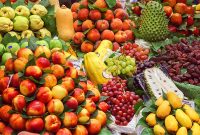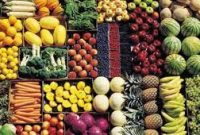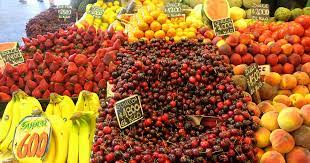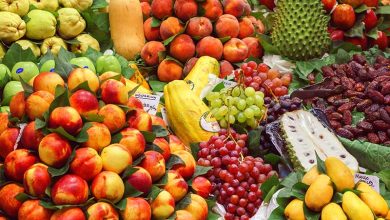The Bounty of Spain: A Gastronomic Exploration of the Vibrant Fruits that Define Spanish Cuisine
FRUITS OF SPAIN

Introduction:
Spain, a nation well-known for its extensive culinary customs, has an abundance of different fruits that not only entice the palate but also capture the nation’s distinct topography and climate. This article takes readers on a delectable tour of Spain’s markets and orchards, examining the historical and cultural importance as well as the culinary joys of the fruits that have come to be considered mainstays in Spanish cooking.
I. The Tapestry of Spain’s Fruitful Regions:
A. Mediterranean Coast: Citrus fruits thrive in the sun-drenched Mediterranean coast of Spain. The warm temperature makes oranges, lemons, and grapefruits grow, which adds to the citrus tastes found in many Spanish cuisine.
B. Andalusian Orchards: Andalusia is a fruit-rich region with a diverse range of fruits due to its warm summers and moderate winters. Andalusia’s orchards add to Spain’s varied gastronomic heritage, from the recognizable olive trees to the delectable, sun-ripened figs and grapes.
C. Valencia and Citrus Fruits: Valencia, dubbed the “orchard of Spain,” is well-known for its citrus crops, including oranges. Valencia oranges, which are prized in both regional cuisine and exports, are a representation of Spain’s citrus sector.
II. Historical and Cultural Significance:
A. Moorish Influences: Spanish cuisine was profoundly impacted by the Moorish colonization of Spain from the eighth to the fifteenth centuries, which brought a multitude of fruits and agricultural techniques. Among this era’s culinary legacies are pomegranates, almonds, and citrus fruits.
B. Festivals and Celebrations: In Spain, fruits are an important part of festivities and festivals. Examples of how fruits became fundamental to cultural events are La Tomatina, the world-famous tomato festival in Buñol, and the hurling of ripe grapes during La Vendimia (wine harvest).


III. Iconic Spanish Fruits:
A. Oranges: Spain’s national fruit is the orange, especially the Valencian variety. Spanish oranges are consumed fresh, juiced, and added to savory and sweet meals. They are prized for their sweet and juicy flavor.
B. Cherries: One of Europe’s biggest cherry producers is Spain. Beautiful cherry orchards may be found in Extremadura’s Jerte Valley, and the region’s yearly cherry blossom festival draws tourists from all over the world.
C. Grapes: In Spain, eating twelve grapes at midnight on New Year’s Eve is a deeply held custom. Grapes are particularly significant to Spanish culture. The varied temperature of the nation makes it possible to grow a wide range of grape varietals, which supports Spain’s well-known wine industry.
D. Olives: Olives are a staple in Spanish cuisine, despite being a fruit. The area is covered with olive trees, and the nation is a major producer of olive oil. The variety of Spanish olives—from Arbequina to Manzanilla—brings richness to the nation’s culinary traditions.
IV. Gastronomic Delights:
A. Sangria and Fruity Libations: Sangria, the traditional Spanish beverage, frequently has a variety of fruits in it, such as berries, oranges, and lemons. The spirit of Spain’s colorful culinary tradition is encapsulated in this delightful combination of wine, fruit juices, and chopped fruits.
B. Desserts and Pastries: Spanish sweets highlight how versatile fruits can be when used in dessert recipes. Spanish pastries highlight the inherent richness of seasonal fruits, from the classic churros with chocolate and churros with dulce de leche to fruit-filled empanadas and tarts.
C. Tapa Creations: Fruit is frequently used into the tapas concept—small plates of different dishes—to provide a taste and freshness boost. Some creative tapa compositions are figs with goat cheese, pomegranate-infused guacamole, and grilled peaches with jamón.
V. Seasonal Harvests and Culinary Traditions:
A. La Vendimia – Grape Harvest: Grape harvest season, or La Vendimia, is when vineyards come alive with celebrations. To commemorate the end of a year’s work in the vineyards, there will be wine tastings, grape stomping, and the savoring of fresh grapes.
B. Almond Blossom Festivals: Springtime is heralded by the blossoming almond trees in places like Mallorca and Murcia. Festivals honoring the beauty of almond blooms frequently include traditional dance, music, and food festivities.


IX. Conclusion:
Spain’s fruit palette, rich in taste and cultural importance, reflects the nation’s rich gastronomic history. Every fruit, from the sun-kissed oranges of Valencia to the charming cherry orchards of Jerte Valley, has a tale to tell about tradition, creativity, and the many varied landscapes that combine to make Spain a foodie’s dream come true. The fruits that adorn Spain’s tables will surely always play a significant role in the nation’s diverse gastronomic landscape as it develops.


